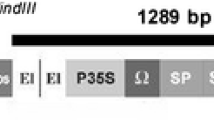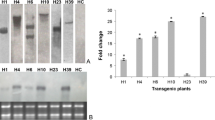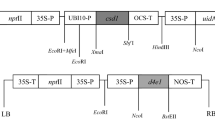Abstract
Citrus canker, caused by Xanthomonas citri subsp. citri (Xcc), is a major bacterial disease responsible for substantial economic losses in citrus-producing areas. To breed transgenic citrus plants with enhanced resistance to citrus canker, two antimicrobial peptide genes, PR1aCB and AATCB, were incorporated into ‘Tarocco’ blood orange (Citrus sinensis Osbeck) plants via co-transformation and sequential re-transformation. The presence of PR1aCB and AATCB in double transgenic plants was confirmed by PCR. The expression of PR1aCB and AATCB in double transformants was demonstrated by quantitative real-time PCR. An in vivo disease resistance assay involving the injection of Xcc revealed that the double transformants were more resistant to citrus canker than the single gene transformants and wild-type plants. An analysis of the bacterial population indicated that the enhanced citrus canker resistance of the double transformants was due to inhibited Xcc growth. These results proved that the pyramiding of multiple genes is a more effective strategy for increasing the disease resistance of transgenic citrus plants than single gene transformations.




Similar content being viewed by others
References
Almeida WAB, Mourão Filho FAA, Pino LE, Boscariol RL, Rodriguez APM, Mendes BMJ (2003) Genetic transformation and plant recovery from mature tissues of Citrus sinensis L. Osbeck Plant Sci 164:203–211
Augustine SM, Narayan JA, Syamaladevi DP, Appunu C, Chakravarthi M, Ravichandran V, Tuteja N, Subramonian N (2015) Overexpression of EaDREB2 and pyramiding of EaDREB2 with the pea DNA helicase gene (PDH45) enhance drought and salinity tolerance in sugarcane (Saccharum spp. hybrid). Plant Cell Rep 34:247–263
Boscariol RL, Monteiro M, Takahashi EK, Chabregas SM, Vieira MLC, Vieira LGE, Pereira LFP, Mourão Filho FAA, Cardoso SC, Christiano RSC, Bergamin Filho A, Barbosa JM, Azevedo FA, Mendes BMJ (2006) Attacin A gene from Tricloplusia ni reduces susceptibility to Xanthomonas axonopodis pv. citri in transgenic Citrus sinensis ‘Hamlin.’ J Am Soc Hort Sci 131:530–536
Cardoso SC, Barbosa-Mendes JM, Boscariol-Camargo RL, Christiano RSC, Bergamin Filho A, Vieira MLC, Mendes BMJ, Mourão Filho FAA (2010) Transgenic sweet orange (Citrus sinensis L. Osbeck) expressing the attacin A gene for resistance to Xanthomonas citri subsp. citri. Plant Mol Biol Rep 28:185–192
Cervera M, Navarro A, Navarro L, Peña L (2008) Production of transgenic adult plants from clementine mandarin by enhancing cell competence for transformation and regeneration. Tree Physiol 28:55–66
Chang MM, Culley D, Choi JJ, Hadwiger AL (2002) Agrobacterium-mediated co-transformation of a pea ß-1,3-glucanase and chitinase genes in potato (Solanum tuberosum L. cv. Russet Burbank) using a single selectable marker. Plant Sci 163:83–89
Cingel A, Savić J, Ćosić T, Zdravković-Korać S, Momčilović I, Smigocki A, Ninković S (2014) Pyramiding rice cystatin OCI and OCII genes in transgenic potato (Solanum tuberosum L.) for resistance to Colorado potato beetle (Leptinotarsa decemlineata Say). Euphytica 198:425–438
Duan S, Jia H, Pang Z, Teper D, White F, Jones J, Zhou C, Wang N (2018) Functional characterization of the citrus canker susceptibility gene CsLOB1. Mol Plant Pathol 19:1908–1916
Dutt M, Grosser JW (2009) Evaluation of parameters affecting Agrobacterium-mediated transformation of citrus. Plant Cell Tissue Organ Cult 98:331–340
Dutt M, Barthe G, Irey M, Grosser J (2015) Transgenic citrus expressing an Arabidopsis NPR1 gene exhibit enhanced resistance against Huanglongbing (HLB; Citrus Greening). PLoS ONE 10:e0137134
Endo T, Shimada T, Fujii H, Kobayashi Y, Araki T, Omura M (2005) Ectopic expression of an FT homolog from Citrus confers an early flowering phenotype on trifoliate orange (Poncirus trifoliata L. Raf.). Transgenic Res 14:703–712
Gentile A, Deng ZN, La Malfa S, Domina F, Germanà C, Tribulato E (2004) Morphological and physiological effects of rolABC genes into citrus genome. Acta Hortic 632:235–242
Guo W, Duan Y, Olivares-Fuster O, Wu Z, Arias CR, Burns JK, Grosser JW (2005) Protoplast transformation and regeneration of transgenic Valencia sweet orange plants containing a juice quality-related pectin methylesterase gene. Plant Cell Rep 24:482–486
Halpin C (2005) Gene stacking in transgenic plants – the challenge for 21st century plant biotechnology. Plant Biotechnol J 3:141–155
Hao G, Stover E, Gupta G (2016) Overexpression of a modified plant Thionin enhances disease resistance to citrus canker and Huanglongbing (HLB). Front Plant Sci 7:1–11
He YR, Chen SC, Peng AH, Zou XP, Xu LZ, Lei TG, Liu XF, Yao LX (2011) Production and evaluation of transgenic sweet orange (Citrus sinensis Osbeck) containing bivalent antibacterial peptide genes (Shiva A and Cecropin B) via a novel Agrobacterium-mediated transformation of mature axillary shoots. Sci Hortic 128:99–107
Khan RS, Darwish NA, Khattak B, Ntui VO, Kong K, Shimomae K, Nakamura I, Mii M (2014) Retransformation of marker-free potato for enhanced resistance against fungal pathogens by pyramiding chitinase and wasabi defensin genes. Mol Biotechnol 56:814–823
Kumari M, Rai AK, Devanna BN, Singh PK, Kapoor R, Rajashekara H, Prakash G, Sharma V, Sharma T (2017) Co-transformation mediated stacking of blast resistance genes Pi54 and Pi54rh in rice provides broad spectrum resistance against Magnaporthe oryzae. Plant Cell Rep 36:1747–1755
Livak KJ, Schmittgen TD (2001) Analysis of relative gene expression data using real-time quantitative PCR and the 2-△△Ct method. Methods 25:402–408
Marutani-Hert M, Bowman KD, McCollum GT, Mirkov TE, Evens TJ, Niedz RP (2012) A dark incubation period is important for Agrobacterium-mediated transformation of mature internode explants of sweet orange, grapefruit, citron, and a citrange rootstock. PLoS ONE 7:e47426
McCormac AC, Fowler MR, Chen DF, Elliott MC (2001) Efficient co-transformation of Nicotiana tabacum by two independent T-DNAs, the effect of T-DNA size and implications for genetic separation. Transgenic Res 10:143–155
Molinari HBC, Marur CJ, Filho JCB, Kobayashi AK, Pileggi M, Júnior RPL, Pereira LFP, Vieira LGE (2004) Osmotic adjustment in transgenic citrus root-stock Carrizo citrange (Citrus sinensis Osb × Poncirus trifoliate L. Raf) overproducting praline. Plant Sci 167:1375–1381
Morris LW, Ducreuxa JML, Fraserb DP, Millamc S, Taylor AM (2006) Engineering ketocarotenoid biosynthesis in potato tubers. Metab Eng 8:253–263
Murashige T, Skoog F (1962) A revised medium for rapid growth and bio assays with tobacco tissue cultures. Physiol Plant 15:473–497
Omar AA, Dekkers MGH, Graham JH, Grosser JW (2008) Estimation of transgene copy number in transformed citrus plants by quantitative multiplex real-time PCR. Biotechnol Prog 24:1241–1248
Peng A, Xu L, He Y, Lei T, Yao L, Chen S, Zou X (2015) Efficient production of marker-free transgenic ‘Tarocco’ blood orange (Citrus sinensis Osbeck) with enhanced resistance to citrus canker using a Cre/loxP site-recombination system. Plant Cell Tissue Organ Cult 123:1–13
Peng A, Zou X, Xu L, He Y, Lei T, Yao L, Li Q, Chen S (2019) Improved protocol for the transformation of adult Citrus sinensis Osbeck ‘Tarocco’ blood orange tissues. Vitro Cell Dev-Pl 55:659–667
Yang L, Hu CH, Li N, Zhang JY, Yan JW, Deng ZN (2011) Transformation of sweet orange [Citrus sinensis (L.) Osbeck] with pthA-nls for acquiring resistance to citrus canker disease. Plant Mol Biol 75:11–23
Zhang Y, Liu Y, Zhang J, Wang G, Wang J, Liu Y (2015) Assessment of transgene copy number and zygosity of transgenic maize overexpressing Cry1Ie gene with SYBR® Green qRT-PCR. Vitro Cell Dev-Pl 51:125–134
Zou X, Peng A, Xu L, Liu X, Lei T, Yao L, He Y, Chen S (2013) Efficient auto-excision of a selectable marker gene from transgenic citrus by combining the Cre/loxP system and ipt selection. Plant Cell Rep 32:1601–1613
Zou X, Peng A, Liu Q, He Y, Wang J, Xu L, Lei T, Yao L, Chen S (2014) Secreted expression of cecropin B gene enhances resistance to Xanthomonas axonopodis pv. citri in transgenic Citrus sinensis ‘Tarocco.’ Acta Hortic Sin 41:417–428
Zou X, Jiang X, Xu L, Lei T, Peng A, He Y, Yao L, Chen S (2017) Transgenic citrus expressing synthesized cecropin B genes in the phloem exhibits decreased susceptibility to Huanglongbing. Plant Mol Biol 93:341–353
Acknowledgements
This research was supported by the Key-Area Research and Development Program of Guangdong Province (2018B020202009), the Earmarked Fund for China Agriculture Research System (CARS-26). We thank Liwen Bianji, Edanz Editing China (www.liwenbianji.cn/ac) for editing the English text of a draft of this manuscript.
Author information
Authors and Affiliations
Contributions
AP designed the experiments, completed the citrus re-transformation, and wrote the manuscript. JZ and XZ completed the citrus co-transformation. LX analyzed the GUS and GFP activities of the regenerants. YH completed the PCR analysis. TL completed the sequencing analysis. LY evaluated the resistance of the transgenic citrus plants to citrus canker. QL completed the expression analysis. SC analyzed the data.
Corresponding authors
Ethics declarations
Conflict of interest
The authors declare that they have no conflict of interest.
Additional information
Publisher's Note
Springer Nature remains neutral with regard to jurisdictional claims in published maps and institutional affiliations.
Supplementary Information
Below is the link to the electronic supplementary material.
Rights and permissions
About this article
Cite this article
Peng, A., Zhang, J., Zou, X. et al. Pyramiding the antimicrobial PR1aCB and AATCB genes in ‘Tarocco’ blood orange (Citrus sinensis Osbeck) to enhance citrus canker resistance. Transgenic Res 30, 635–647 (2021). https://doi.org/10.1007/s11248-021-00245-y
Received:
Accepted:
Published:
Issue Date:
DOI: https://doi.org/10.1007/s11248-021-00245-y




